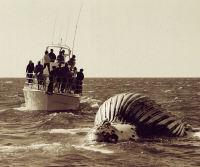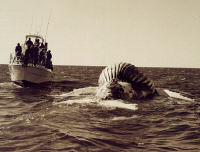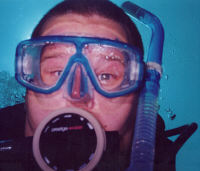“What the fuck is that smell?” cried Brad.
The trip to the Muiron Islands, a scuba paradise off the coast of Western Australia, had been going to plan before this point. Sea snakes and turtles popped their heads out the water as the boat crashed past, watching as we cut a path through the large ocean swell. Most of the divers were sleeping below deck, but a few of us had shuffled outside to smoke cigarettes and watch the sea mist evaporate in the early morning sun.

A stench of rotting fish suddenly engulfed the boat, producing a chorus of profanity and a synchronised movement of hands to faces. Bob, the ship’s Captain, quickly solved the mystery. Slowly he lowered his binoculars and announced in a sad tone that it was a dead humpback whale, floating up ahead, rising from the water like a small island. The engines died and the boat baffled towards the listless corpse.
The whale lay spread-eagle on its back. Fins outstretched and chest swollen to the sky, looking to heaven for the divine intervention that never arrived. Our sorrow etched faces shifted to shock as the first tiger shark attacked, ripping into the whale’s fin and twisting violently from side to side. Two more sharks appeared, taking it in turns to rip meat from the whale’s fleshy jaw that hung limp in the water. We watched quietly, “ooh’s” and “ahh’s” escaping our lips like children watching fireworks.
After watching the attack for several minutes, Bob started the engines, supplying a jolt of adrenalin by announcing with a macabre grin that it was “time to go diving”. We left the whale in our wake and a queue of nervous divers formed outside the toilet.

Scuba diving is a sport that has its dangers. Most dives go without a hitch, but occasionally the ocean likes to remind you how vulnerable a cumbersome human can be. The chances of getting attacked by a shark are tiny, but it does occasionally happen. Tiger sharks are responsible for approximately 22% of all human shark attack fatalities – second only to the great white shark – so they deserve a little respect.
We were now a mile or so away from the whale carcass, but the awesome images of attack were still vivid in my mind. An uneasy silence prevailed as we pulled on wetsuits and checked kit. Like it not, it was time to dive.
We descended into the blue murk. Huge coral gardens lay before us sheltering a mirage of colourful reef fish being swept back and forth in the surge. Thoughts of the sharks haunted me as we shot through colourful crevices and subterranean overhangs. Each time we turned a corner I expected to come face to face with 10-feet of toothy terror, but instead met inquisitive sea snakes gazing at their reflections in my glass mask.
Potato Cod cruised past and moray eels regarded us from the sanctuary of their coral homes. A manta ray graced us with its presence, swooping past in poetic silence, before circling overhead and departing like a dream. Our visual feast was accompanied by the extraordinary sound of humpback whales, singing through miles of blue soup to confuse and engulf us. We couldn’t see them, but they certainly let us know they were there.

Reluctant to rise, but running low on air, we surfaced. Post-dive euphoria kicked in as we clambered up the ladder and onto the boat, ten excited divers all trying to talk at once. Brad was last to surface, floating behind the boat as he removed his fins. The sight of a dorsal fin in the water immediately froze our jabbering mouths. Shocked silence fell over the boat.
Brad, sensing something was wrong, turned to see it cutting through the water towards him, 20-feet and closing. Tiger Sharks? Everyone held their breath, waiting for the inevitable impact. A bottlenose dolphin suddenly erupted from the water, sailing over Brad’s head and looping through the air, a playful grin fixed on its face. Was it laughing at us?
Questions?
If you want more information about this area you can email the author or check out our Australia Insiders page.
![]()